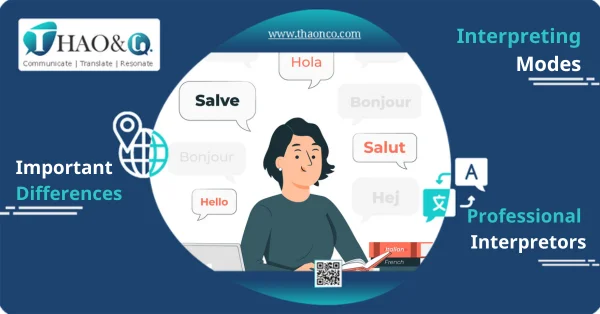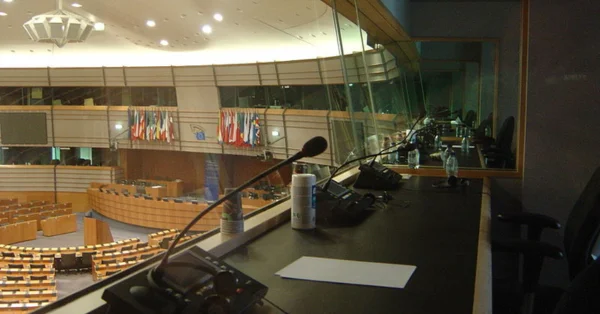Interpreting is a form of verbal translation that helps facilitate information exchange among the involved parties. There are many modes of interpreting. Depending on your needs and the nature of the discussion, you can choose the most suitable one.
Interpreting comes in many diverse forms, with 11 common types: These can be divided into 2 main groups:
To choose the interpreting form that most suits your needs, it’s essential to distinguish between common modes of interpreting. Also, take into consideration the languages involved, the scale, and the nature of the event before seeking interpretation services.
Depending on the manners of interpreting, language interpreting can be categorized into:
This is currently one of the most common types of interpreting. After the speaker finishes a statement or a short part of their speech, the interpreter proceeds to convert the source language to the target language.
Consecutive interpreting is often used in small meetings with a small number of
, such as interviews, employee training sessions, presentations, tour guides, press conferences, business negotiations, exhibitions, and others.
Consecutive interpreting is widely chosen for its high accuracy since interpreters have time to take notes and decide on the most appropriate word choices. However, a meeting using consecutive interpreting will likely take longer compared to other modes of interpreting.

Simultaneous interpreting is considered one of the most challenging modes of interpreting, requiring a wide range of skills. The message is interpreted as the speaker delivers their speech.
The interpreter sits in a booth equipped with a microphone and specialized headsets. The interpretation is conducted simultaneously so that the attendees can understand what the speaker is saying. In most cases, when the speaker completes a sentence, so does the interpreter.
Simultaneous interpreting is favored for its privacy and time-saving nature. This mode of interpreting is suitable for events that take place swiftly and uninterrupted with a large number of attendees coming from various countries, such as international conferences, webinars, live television, colloquiums, shareholders meetings, board of director’s meetings, multinational court hearings, etc.
Whisper interpreting is similar to simultaneous interpreting. However, the interpreter only translates for a small group of around 1-3 people by whispering quietly into their ears at an appropriate volume.
Whisper interpreting is often used in negotiations, internal meetings, site visits, etc. where privacy and confidentiality of information are priorities. However, having many interpreters simultaneously translating into multiple languages could be distracting for the interpreters and make it difficult for listeners to follow the information.
Relay interpreting or Indirect interpreting uses a third language as the means to translate between two languages. This is employed when there’s a limited availability of interpreters proficient in a rare language pair. For example: When Japanese and Lao partners convene, English is typically used as a bridge for information exchange.
This mode of interpreting is usually combined with simultaneous interpreting in international conferences with the participation of worldwide experts. Indirect interpreting saves costs and time in finding the right interpreters. But it can come with the risk of information being “lost in translation.”
Team interpreting is a common practice, accounting for a large number of interpreting assignments. Team interpreting refers to situations where 2-3 interpreters take turns translating a language pair.
This mode of interpreting is typically used for extended translation sessions that demand a high level of concentration. Interpreters take turns working to maintain the quality and productivity of the translation process.
Team interpreting, however, may lead to inconsistency without thorough vetting and preparation. In addition, it typically costs more due to the need for more interpreters.
Liaison interpreting or bilateral interpreting requires interpreters to conduct a two-way translation. This mode of interpreting places heavy demands on interpreters, requiring strong language skills, a nimble switch between two languages, and extensive experience.
Sign language interpreters are considered a cultural intermediary supporting people with hearing impairment. Sign language interpreters provide conversion of spoken language into sign language and vice versa to facilitate communication for people with hearing impairment.

Interpretation can be categorized by the location where it takes place:
On-site interpreters work at the place where the meeting occurs. In most cases, being a professional on-site interpreter also requires good communication skills and adept situation handling similar to that of an event organizer or staff member to maintain professionalism in front of clients.
In this age of globalization, remote interpretation is gaining popularity thanks to its speedy, convenient, and cost-saving nature. With remote interpretation, parties who are unable to meet in person can still exchange information through tools such as Zoom, Google Meeting, Skype, etc.
Remote interpretation is practically similar to traditional interpretation. Nevertheless, remote interpreters must be proficient in using technological equipment and platforms. And a stable Internet connection is essential for interpreting sessions.
This form of interpreting is utilized when the interpreter and all parties can’t meet in person. Instead, the interpretation proceeds over the phone. Normally, over-the-phone interpretation is conducted consecutively to ensure high accuracy.
If your plans involve business trips, site visits, and inspections with partners at locations such as factories, events, workshops, courts, etc., then Escort Interpreting is the ideal choice.
Escort interpreters will always be by your side to assist with conveying your messages and receiving information from others. In addition, depending on the agreed terms, the escort interpreter can help navigate difficulties in cultural nuances and daily activities throughout the trip.
The nature of Escort Interpreting involves short or extended trips covering multiple locations. Therefore, besides language skills, escort interpreters must meet the requirements of good health and the ability to undertake regular business trips.

Thao & Co. takes pride in being the trusted interpretation partner of global clients over the years. We have hands-on experience in a wide range of interpretation projects with diverse modes of interpreting, content, and industries.
Client satisfaction is our top priority. Our team of native linguists is highly qualified, with years of experience in translation and interpretation.
We provide professional interpreting services, ensuring that all information is conveyed accurately and in alignment with the cultural preferences of your audience.
Need expert interpretation? Partner with Thao & Co. to enjoy:
There are many types of interpreting. Choosing the right one for your event is important to ensure seamless communication.
If you’re still not sure which one is the right choice for your needs, please leave your details on our Get a Quote page, and we will get back to you as soon we can.